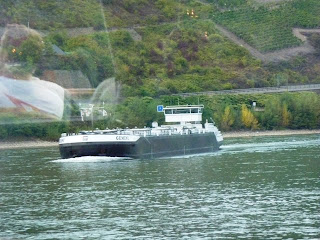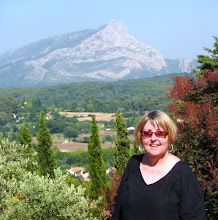The only mistake we made on this early part of the trip was to believe what someone told us on the train -- rather than what I had in my notes. There are two train stops in Bingen. My notes said that one was closer to the boat dock and he said the other one was. He was wrong, but we got there in plenty of time even if we did have to walk about a mile with our packs.
This is the ship we took. I guess it's really more of a ship than a ferry since it's walk on only.
 I was concerned about eating on the ship, but when we got on we discovered that the whole thing except outside was a restaurant! We had a very nice meal after which Trout went out on the prow and promptly fell asleep. I don't know how much of the scenery he actually saw.
I was concerned about eating on the ship, but when we got on we discovered that the whole thing except outside was a restaurant! We had a very nice meal after which Trout went out on the prow and promptly fell asleep. I don't know how much of the scenery he actually saw. The ship was named the Goethe and it's a paddle wheeler. Kids had a great time messing around with this display.
The ship was named the Goethe and it's a paddle wheeler. Kids had a great time messing around with this display. The sides of the hills down to the Rhine are very steep but they are still covered in vineyards in most areas.
The sides of the hills down to the Rhine are very steep but they are still covered in vineyards in most areas.

 This is a treacherous area known as the Loreley. The Japanese seem to be particularly drawn to this legend about the beautiful woman who lures skippers to crash their boats. The closest stop to it was where they all got off together.
This is a treacherous area known as the Loreley. The Japanese seem to be particularly drawn to this legend about the beautiful woman who lures skippers to crash their boats. The closest stop to it was where they all got off together. The Rhine is not just for tourists. It's a major artery of commerce. Most of the barges are Dutch, Belgian or German. They will fly their national flag, have living quarters for the family who owns them and the people who work for that family. Sometimes they even show off their cars on the decks.
The Rhine is not just for tourists. It's a major artery of commerce. Most of the barges are Dutch, Belgian or German. They will fly their national flag, have living quarters for the family who owns them and the people who work for that family. Sometimes they even show off their cars on the decks.This is a Dutch barge.
 The main reason tourists take this slow route along the Rhine is to see castles. You can get on and off to do that. We didn't, but there are a lot of them.
The main reason tourists take this slow route along the Rhine is to see castles. You can get on and off to do that. We didn't, but there are a lot of them.This one is in the middle of the river on Pfalz Island and was built specifically to charge people to use the river.
 This is Burg Katz. It was purchased by some Japanese entrepeneurs to make into a hotel because it is so close to the Loreley. They wanted to completely modernize it inside, but the German government said, "nein!"
This is Burg Katz. It was purchased by some Japanese entrepeneurs to make into a hotel because it is so close to the Loreley. They wanted to completely modernize it inside, but the German government said, "nein!"
 This is Burg Maus. It's close, but not too close, to Burg Katz.
This is Burg Maus. It's close, but not too close, to Burg Katz.
 This is Marksburg Castle, the only one along the Rhine to never have been destroyed.
This is Marksburg Castle, the only one along the Rhine to never have been destroyed.
 This is the main entrance, up some stone stairs set into and carved out of the rock.
This is the main entrance, up some stone stairs set into and carved out of the rock.
 This is another angle on the setting.
This is another angle on the setting.
 And one with me on the wall of the road to it. We parked in the parking area and walked down to the castle, but we took a shuttle back up the hill to our car.
And one with me on the wall of the road to it. We parked in the parking area and walked down to the castle, but we took a shuttle back up the hill to our car.
 Remember, this castle was built in medieval times, so these guardstations and guideposts along the way are very old and some are in ruins.
Remember, this castle was built in medieval times, so these guardstations and guideposts along the way are very old and some are in ruins.

 The castle actually had 3 branches of the same family living there, so there are 3 sections, sort of like a condominium.
The castle actually had 3 branches of the same family living there, so there are 3 sections, sort of like a condominium.
 Because of the siting, the central courtyard is very small with high structures on all sides.
Because of the siting, the central courtyard is very small with high structures on all sides.



 Here is Trout waiting for our tour to begin.
Here is Trout waiting for our tour to begin.
 The stairwell to the left is the one we used to enter and leave the courtyard.
The stairwell to the left is the one we used to enter and leave the courtyard.



 This is a detail from the courtyard. Remember, this was built when Catholic was the only version of Christianity that existed -- long before Martin Luther.
This is a detail from the courtyard. Remember, this was built when Catholic was the only version of Christianity that existed -- long before Martin Luther.

Here's Trout at the other end of the small courtyard inspecting a door with another stairwell behind him.
 And here's a very subtle sign to the toilets.
And here's a very subtle sign to the toilets.
 After the tour, we drove down the Mosel to Koblenz. I had walked off with the key to our Koblenz hotel room and we needed to do laundry anyway. There was no place to do it near the Nurburgring and I didn't want to pay the price at the hotel (2 Euros for a pair of panties, get real). So we returned the key to our Koblenz hotel. The person there told us where a laundry was about 2 blocks away. We went to it and were able to park on the street right in front. Then the fun began.
After the tour, we drove down the Mosel to Koblenz. I had walked off with the key to our Koblenz hotel room and we needed to do laundry anyway. There was no place to do it near the Nurburgring and I didn't want to pay the price at the hotel (2 Euros for a pair of panties, get real). So we returned the key to our Koblenz hotel. The person there told us where a laundry was about 2 blocks away. We went to it and were able to park on the street right in front. Then the fun began.  You can see Trout was helping.
You can see Trout was helping.
 What we experienced here was repeated all over Europe in the "modern" laundromats. You buy soap usually from a dispenser. It doesn't come out in a box, but rather into a cup. You pay for everything in a central location by selecting the number of the machine and putting your money in. In the less modern places, you pay someone else to do it for you or you pay them directly and then turn on the machines. Sometimes you just dip a cup into a big bag of detergent.
What we experienced here was repeated all over Europe in the "modern" laundromats. You buy soap usually from a dispenser. It doesn't come out in a box, but rather into a cup. You pay for everything in a central location by selecting the number of the machine and putting your money in. In the less modern places, you pay someone else to do it for you or you pay them directly and then turn on the machines. Sometimes you just dip a cup into a big bag of detergent.
 This is Burg Katz. It was purchased by some Japanese entrepeneurs to make into a hotel because it is so close to the Loreley. They wanted to completely modernize it inside, but the German government said, "nein!"
This is Burg Katz. It was purchased by some Japanese entrepeneurs to make into a hotel because it is so close to the Loreley. They wanted to completely modernize it inside, but the German government said, "nein!" This is Burg Maus. It's close, but not too close, to Burg Katz.
This is Burg Maus. It's close, but not too close, to Burg Katz. This is Marksburg Castle, the only one along the Rhine to never have been destroyed.
This is Marksburg Castle, the only one along the Rhine to never have been destroyed.Okay, so we traveled the Rhine from Bingen to Koblenz. We spent the night in Koblenz, got our rental car the next day (the 8th) and went to the Nurburgring. Since Trout was not able to get a car to drive the Nurburgring on the 9th, he did it the 8th. That actually worked out great because we had the whole day of the 9th to explore the countryside and the only castle we saw on the whole trip.
So now we move inland. This is Burg Eltz. It's been in the same family for 800 years. We managed to arrive in time to be on an English language tour. They don't allow pictures inside so the the only pictures here are of the exterior.
 This is the main entrance, up some stone stairs set into and carved out of the rock.
This is the main entrance, up some stone stairs set into and carved out of the rock. This is another angle on the setting.
This is another angle on the setting. And one with me on the wall of the road to it. We parked in the parking area and walked down to the castle, but we took a shuttle back up the hill to our car.
And one with me on the wall of the road to it. We parked in the parking area and walked down to the castle, but we took a shuttle back up the hill to our car. Remember, this castle was built in medieval times, so these guardstations and guideposts along the way are very old and some are in ruins.
Remember, this castle was built in medieval times, so these guardstations and guideposts along the way are very old and some are in ruins.
 The castle actually had 3 branches of the same family living there, so there are 3 sections, sort of like a condominium.
The castle actually had 3 branches of the same family living there, so there are 3 sections, sort of like a condominium. Because of the siting, the central courtyard is very small with high structures on all sides.
Because of the siting, the central courtyard is very small with high structures on all sides.


 Here is Trout waiting for our tour to begin.
Here is Trout waiting for our tour to begin. The stairwell to the left is the one we used to enter and leave the courtyard.
The stairwell to the left is the one we used to enter and leave the courtyard.


 This is a detail from the courtyard. Remember, this was built when Catholic was the only version of Christianity that existed -- long before Martin Luther.
This is a detail from the courtyard. Remember, this was built when Catholic was the only version of Christianity that existed -- long before Martin Luther.
Here's Trout at the other end of the small courtyard inspecting a door with another stairwell behind him.
 And here's a very subtle sign to the toilets.
And here's a very subtle sign to the toilets. After the tour, we drove down the Mosel to Koblenz. I had walked off with the key to our Koblenz hotel room and we needed to do laundry anyway. There was no place to do it near the Nurburgring and I didn't want to pay the price at the hotel (2 Euros for a pair of panties, get real). So we returned the key to our Koblenz hotel. The person there told us where a laundry was about 2 blocks away. We went to it and were able to park on the street right in front. Then the fun began.
After the tour, we drove down the Mosel to Koblenz. I had walked off with the key to our Koblenz hotel room and we needed to do laundry anyway. There was no place to do it near the Nurburgring and I didn't want to pay the price at the hotel (2 Euros for a pair of panties, get real). So we returned the key to our Koblenz hotel. The person there told us where a laundry was about 2 blocks away. We went to it and were able to park on the street right in front. Then the fun began. My German was obviously not up to this, but someone helped us to figure out what to do. And that someone was not the clean cut female student but rather the heavily tatooed and pierced scary looking guy.
 You can see Trout was helping.
You can see Trout was helping. What we experienced here was repeated all over Europe in the "modern" laundromats. You buy soap usually from a dispenser. It doesn't come out in a box, but rather into a cup. You pay for everything in a central location by selecting the number of the machine and putting your money in. In the less modern places, you pay someone else to do it for you or you pay them directly and then turn on the machines. Sometimes you just dip a cup into a big bag of detergent.
What we experienced here was repeated all over Europe in the "modern" laundromats. You buy soap usually from a dispenser. It doesn't come out in a box, but rather into a cup. You pay for everything in a central location by selecting the number of the machine and putting your money in. In the less modern places, you pay someone else to do it for you or you pay them directly and then turn on the machines. Sometimes you just dip a cup into a big bag of detergent.We did laundry in Koblenz, Rome, at Ramona and Jason's, Carcassonne, Madrid, Paris, London, Glasgow and Dublin. If you count up, that's about once a week. Koblenz and Rome were the most expensive at about 20 Euros each, but in Rome they did it for us. The cheapest was at Ramona and Jason's of course where it was free, but the next cheapest was in Glasgow where it was 6.50 Pounds. However that doesn't count the 12 Pound round trip in a taxi to get to a place that was open on Sunday.
I washed out underwear a few times along the way so as to not have to do laundry too soon, but Trout took more clothes than I did, so he really didn't need to do laundry as often as I did. Some people would see this as a waste of time from site seeing, but we found it interesting to see how the locals who lack their own machines tackled this frequent chore.











